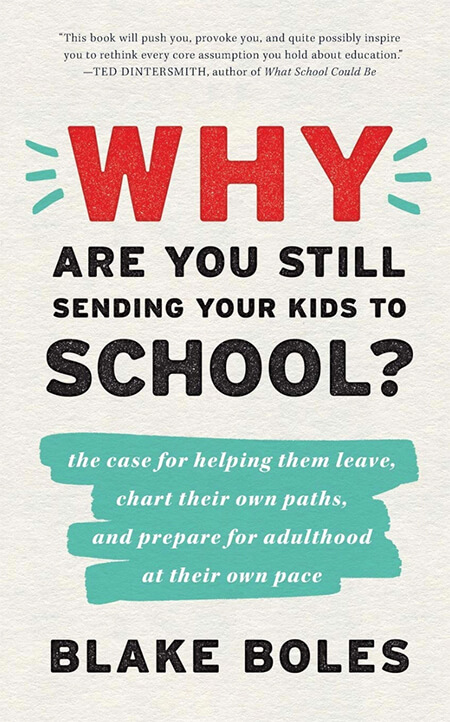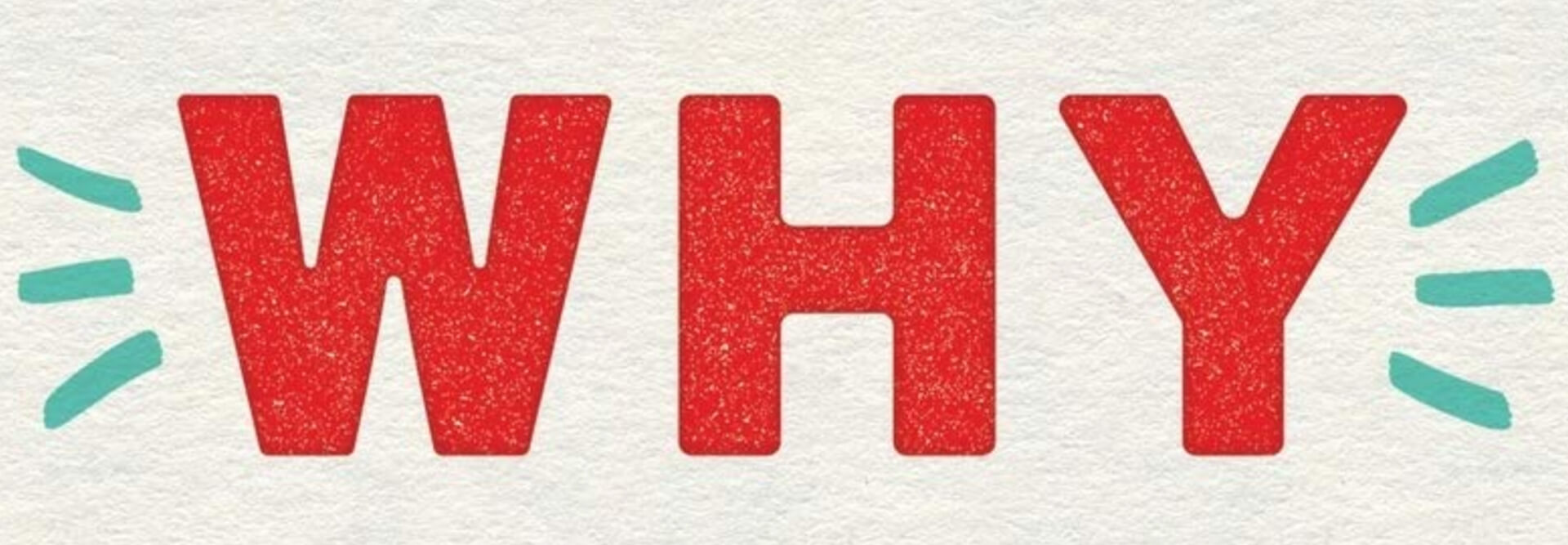
For newcomers to Self-Directed Education (SDE), it can be challenging to find a comprehensive resource describing prevalent models and relevant research, as well as succinct and straightforward answers to the basic questions: why does conventional education fail to work for so many students? How do SDE students learn anything? Do they turn out ok? Really? For practitioners of SDE, it can be challenging to avoid becoming rigidly aligned with our own preferred model.
The good news is that there’s a new book in town, and it will be an important tool in overcoming these challenges: Why are You Still Sending Your Kids to School? by preeminent SDE spokesperson and practitioner Blake Boles. Boles’ voice is a bridge between the world of SDE and the mainstream. I have always thought the quality that best describes Boles’ demeanor is balance; he is a fulcrum of evenhandedness and boldness. He manages to be inspiring and idealistic while remaining fair, critical, and honest. He acknowledges the limitations of SDE while lucidly illuminating its power. And he treats the various models of SDE as tools that families might use in turn, rather than distinct philosophies demanding a lifetime commitment. Boles is able to manage that because he walks the walk: he’s the entrepreneurial player-coach of SDE, living his own life as an adventure of expansion while he creates tools, writes books, and facilitates activity for the SDE community.
Why are You Still Sending Your Kids to School? is highly accessible in its approach, structure, and content, and its primary utility will be inviting new faces into the SDE fold. I am hopeful that we will use it that way by promoting and offering it as the introduction to what we do – on the first page Boles writes, “This is a practical book about what you can do, beginning today, if you believe that mainstream schools, which I call conventional schools, may be a bad fit for your child.” Boles does a very good job orienting the uninitiated into the structural problems posed by conventional education, and unconventional education’s answers to them, and it also provides a survey of the most prevalent models of SDE, furnishing readers with a basic mastery over the landscape. Just as importantly, Boles is understanding, rather than dismissive, of parents’ concerns about SDE, and he sits and thinks alongside them. He sets the tone for this attitude in his introduction, writing,
If this is your first time reading a book that broadly criticizes conventional schooling, you may be feeling a bit defensive right now. School as an oppressive institution? School as the new child labor? If you succeeded in the conventional school system, I understand that I may be testing your patience.
Boles maintains this measured and respectful approach throughout; he’s not a crank here to tell you that you’re wrong about everything, he’s a thoughtful professional here to share information. He assembles and presents the research on SDE, provides many through real-life examples of how SDE works, and gently but honestly assesses what an SDE approach demands of both students and parents. The book also features a superb extended passage on gaming sure to turn the heads of even the most dyspeptic critics of this profoundly important 21st century activity.
Why are You Still Sending Your Kids to School? has more to offer SDE practitioners than a mere SDE promotional resource. We need to be able to talk coherently and convincingly to young people and their families about college, and Boles is one of the best resources out there on the topic; in this book, he includes an excellent chapter which demystifies the challenges related to college admissions and success for SDE students. Boles’ own work has focused on teens, and he challenges SDE orthodoxy in his sub-chapter on working with them. He writes,
When a child is playing, we adults should try hard to not interfere. Play is a child’s work, and you wouldn’t like it if someone kept interrupting your work, would you? This is a common argument in the world of self-directed learning, and it applies splendidly to young children. In adolescence, however, I don’t believe we can place absolute faith in the power of free play...
There is a blurry line between childhood play and adult work that the advocates for unlimited free play don’t address — and this blurriness holds many parents back from supporting educational alternatives that could otherwise help their kids.
This section contains important insights into the in-between-ness that marks this stage of life, and will provide much fodder for consideration to SDE practitioners who likewise work with teens.
Perhaps most importantly for the SDE community, this book emphasizes and demonstrates the commonality in philosophy and approach which we all share. The first chapter includes a description of what it might be like for the reader to spend a “day-in-the-life” of an SDE center, which concludes with this passage,
You have a moment of panic. “This isn’t how school is supposed to feel,” you tell yourself. No one is nervously preparing for a test. No one is being lectured to or doing homework. No one is being questioned by an adult, aside from that conversation you passed in the kitchen, where a staff member was challenging three adolescents’ beliefs about vegetarianism. What’s so unnerving about this place? You dwell on this question for moment. Maybe it’s the fact that these kids don’t seem to be worrying about their futures. Maybe it’s the fact that the whole place feels too open, relaxed, accepting, and free. Kids, open your eyes! Don’t you know it’s a cold, harsh world out there? You can’t afford to be this relaxed! Get to work! As the day ends, you notice that most kids just wander out the front door. A few parents pop in, give their kid a hug, and walk out together to the car. Some kids take the public bus, others get rides with friends. You wait for the final bell — a conditioned response from your own years in school — but it never comes. In fact, you haven’t heard a single bell all day.
Boles then points out that the reader may have had the experience he describes in a Liberated Learner Center, an Agile Learning Center, or a Sudbury School, reminding us that the core experience is often identical. Later, after describing unschooling in depth, Boles writes,
I encourage you to fly no flag. Don’t join the unschoolers and never look back. Instead, pledge allegiance only to the young person in your charge. Familiarize yourself with the full spectrum of options. Whenever you feel like you’ve found the answer to your kid’s educational needs, add the words: for now.
This is the liberatory power of this book for SDE practitioners. For all of us, the world is small. We have few allies and many critics, and what we do is primarily a labor of love. So it comes as no surprise that many of us, myself most certainly included, become defensive and dogmatic from time to time. We might do well to “fly no flag” and speak about the various models of education, including conventional ones, as models which work for different young people at different points in their educational journeys. Doing so will also improve our credibility with skeptics and mainstream thinkers, because it’s a) honest, and, b) less threatening than suggesting that we have the One True Educational Model. I believe that taking the “fly no flag” approach will also align us more closely with our own values of self-determination, exploration, and conscious living.
Why are You Still Sending Your Kids to School? is able to accomplish a lot in a mere 240 pages. It introduces Self-Directed Education to a general audience in compelling fashion, surveys and unites the various flavors of practice, and assembles the relevant data in one place. Blake Boles facilitates a lot of connections and builds a lot of bridges, and this book is going to do that too. And it’s going to get a lot of people switched on, which is what Boles is all about: “it doesn’t matter,” he writes, “in the end, where the spark comes from. It only matters that your child’s fire burns brightly.”
If you enjoyed this article and feel called to give back to ASDE, here are ways you can support our work:
- Donate money
- Share our content with others! Click one of the buttons above to easily share on Twitter, Facebook, or email.
- Consider becoming a Contributor for Tipping Points
Tipping Points Magazine amplifies the diverse voices within the Self-Directed Education movement. The views expressed in our content belong solely to the author(s). The Alliance for Self-Directed Education disclaims responsibility for any interpretation or application of the information provided. Engage in dialogue by reaching out to the author(s) directly.






